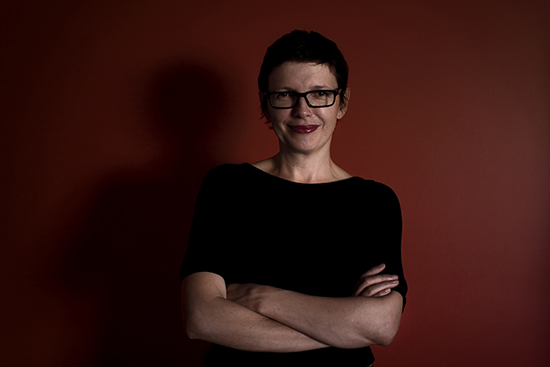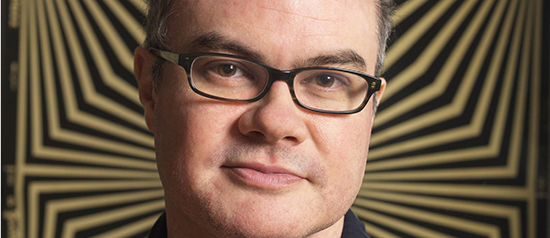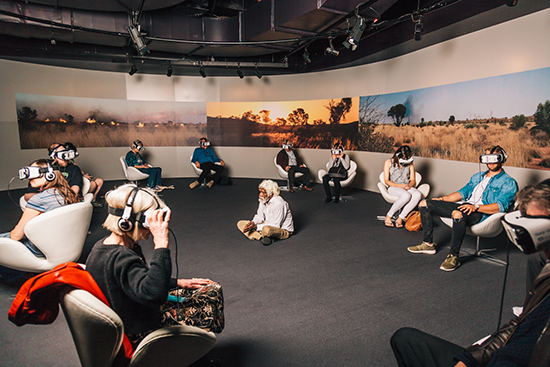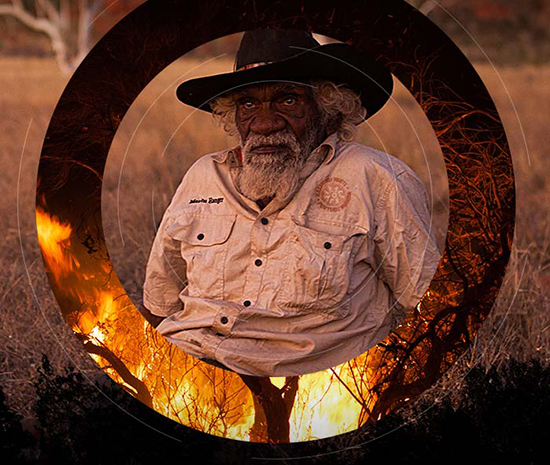ACMI Mark II: Museum of the future
Dan Edwards: interview, ACMI Director Katrina Sedgwick

Katrina Sedgewick
photo Michael Clements courtesy ABC
Katrina Sedgewick
I’m waiting in the reception area of ACMI X, the new “shared co-worker” space behind Melbourne’s Art Centre, created by the Director of the Australian Centre for the Moving Image (ACMI), Katrina Sedgwick. The decor is all post-industrial chic, with concrete floors, exposed air conditioning ducts and corrugated plastic sheets on the wall.
Later, I’m taken through a series of open-planned desks, a large kitchen and event space, editing suites, meeting rooms and a cute library nook. ACMI staff—previously scattered across several offices in Melbourne’s CBD—have been brought under one roof here, and the local branch of the National Film and Sound Archive (NFSA) occupies one corner. Desks are let to a diverse range of tenants, from contemporary art group Aphids to digital studios working on virtual reality technology such as Sandpit, to a screenwriter sponsored by the Copyright Agency.
This is Sedgwick’s vision for ACMI in physical form—an outward-looking institution engaged with industry and the broader creative sector, overseeing a conceptual space in which people, forms and ideas intermix. In her office at the centre of it all, I spoke with Sedgwick about her far reaching plans for ACMI as she approaches her second anniversary at the organisation’s helm.
Tell me about the space we are currently in, ACMI X.
The co-working space is 60 desks, and it houses a really diverse range of practitioners, companies and businesses who work across our remit—the moving image. It’s all about cross-disciplinary opportunity and collaboration, to have practitioners and makers from all sorts of different industries in our space every day—to be standing next to them making coffee, having conversations and allowing that sort of spontaneous interaction to feed into how we work, and hopefully leverage our resources back out to the sector. We moved in in March, and the co-workers have been here since May.
Do people and groups apply for a desk, or are they invited?
They apply and then we decide. It’s all about diversity.

Seb Chan
photo courtesy ACMI
Seb Chan
EXTENDING THE MUSEUM EXPERIENCE
Last year, you were quoted in Fairfax media saying that “a really significant shift” is planned around the way “ACMI audiences experience our content.” Can you elaborate on what that shift will comprise, and the role your new “Chief eXperience Officer” Seb Chan will be playing in that change?
I can’t get into specifics, as we’re working on a whole lot of those programs now. But in broad strokes, look at Seb’s background and the work he has done previously at the Cooper Hewitt Smithsonian Design Museum in New York which has series of three-dimensional display objects, in a very traditional museum sense. These have been digitised, and there is a device—a digital ‘pen’ that was developed by Seb and his team—that allows a way of collecting that experience and continuing it when you get home, and sharing that with your friends and family really easily. It’s that idea of extending the conversation with the museum’s visitor before, during and after the visit, rather than it being a passive, come-and-consume experience. That’s where we’re heading, and Seb is central to our being able to develop a vision for that.
So digital technologies are central to the changes you envision for the visitor experience at ACMI?
There is a creative opportunity to change the way we work and connect with audiences using new digital tools—beyond marketing. Everyone’s got their heads around social media, but actually we have the opportunity to tell stories in completely different ways.

Audience experience Collisions, VR film by Lynette Wallworth
photo Renee Stamatis courtesy ACMI
Audience experience Collisions, VR film by Lynette Wallworth
MINING DIGITAL POTENTIAL
In the very first Adelaide Film Festival I did back in 2003 [Segdwick headed the festival 2002–12], we did a crossover digital lab encouraging filmmakers to consider digital tools and different ways they could create work. By the time I left the festival a decade later, the conversation hadn’t changed one bit. Then I went to the ABC, which was all about digital, and it was still the same conversation with the film and television industry that was going on 14 years earlier. People have not got their heads around all of the creative potential that is there.
Why do you think there is that resistance?
I think it’s really generational. And the way funding is set up, the way the broadcasters and agencies work…
All those structures have been in place for a long time, and they were really built for a different era.
It’s about old school approaches for a certain group of people—mainly older white men—working in a particular way. And it has not changed in my time in the film industry, which is now 16 years. So it was very clear to me when I got the ACMI job that I needed to get someone who was a really incredible progressive thinker, who was able to look three years ahead of anybody else. So that title and position of Chief eXperience Officer was created because I knew I could get Seb Chan. For me he was precisely the person I needed.
So can we expect to see the level of change that Seb delivered at the Cooper Hewitt in New York here at ACMI?
Absolutely.
That’s quite a dramatic change.
It is. For Cooper Hewitt they were doing a massive renovation and previously their principle demographic was women over 50 who lived within a two-kilometre radius of the museum on the Upper East Side of New York. We’re in an utterly different position. We had nearly 1.5 million people come through the building last year. Clearly we have a series of stories the audience wants. What we’re interested in is how we make that better. How do we make ourselves a truly innovative institution that is at the forefront of 21st century museum practice?
Will that mean physical changes to the main cinema and exhibition space on Federation Square?
There will be some physical changes and shifts in content. The permanent exhibition is coming up to 10 years old and needs a significant reimagining. But we’re certainly not knocking down the building and starting again. It’s about reconfiguring and better connecting what we have. If someone comes in to see a David Bowie exhibition downstairs, how do they connect with the fact that four floors above them are two fantastic cinemas? We find that audiences in fact don’t currently connect. So there’s a series of tools to bring in, some of which are as simple as a visitor guide with a map [laughs]. People will see changes as we go, but I think the big bang will be around 2019–20 which will lift the curtain on ACMI mark II.
BEING A MUSEUM AND PROUD OF IT
Apart from appointing Seb, what changes have you already made since your arrival in early 2015?
Firstly to our overall strategy. We’re now describing ourselves as a museum. That’s been an interesting move. When I came for my interview I was talking about being a 21st century museum, and I was asked, “Why are you calling it a museum? We’re not a museum.” And I said, “I think we are.” We have a 160,000-object collection that we preserve and provide access to. We have a permanent exhibition that our audience interacts with, we have temporary shows and we have a team of curators and a dynamic exhibition team. We also have cinemas that show cultural and art objects. And we have a connecting social space. I think those things make us a museum rather than a gallery or centre.

Nyarri Nyarri Morgan, Collisions VR film by Lynette Wallworth
photo Piers Mussared courtesy ACMI
Nyarri Nyarri Morgan, Collisions VR film by Lynette Wallworth
OPENING DOORS
The next big shift was opening the doors on Flinders Street. We had one entrance when I arrived, on Federation Square. Now we have two. That had the immediate impact of increasing our visitations by 200,000 people per year. It also started a rich conversation about how we engage with our audiences and their journey through the institution. You see that reflected in our corporate strategy, thinking very holistically as an institution, to connect all the different parts of what we do.
ARCHIVE ACTION + NEW COMMISSIONING
We’ve created a collection strategy, which I think is really robust and really the first one we’ve done. It has triggered a whole lot of conversations around our collection and how we make our archive—as well as the NFSA archive—more accessible and as easy, playful and fun as it could possibly be. We’ve signed a new memorandum of understanding with the NFSA and begun a series of projects with them over the next three years. Ultimately our philosophy will deliver a very participatory archive; one where the content is as sharable, playable and re-mashable as it can possibly be.
We’ve commissioned three virtual reality pieces over the past 12 months, and we currently have Lynette Wallworth’s Collisions—the first time we’ve exhibited a single virtual reality work as a major exhibition piece.
So, more commissioning, more responsiveness and spontaneity. We’re very audience focused, we’re leveraging our collection and the ACMI X co-working space represents a shift to a more visible and ongoing connection with the breadth of industries that we showcase.
Australian Centre for the Moving Image, Federation Square, Melbourne
More information about the ACMI X co-working space, including application forms, can be found at www.acmi.net.au/acmi-x
Now at ACMI: Philippe Parreno is a leading French synthesiser of visual art and film, creating installations that play disorientingly with time and space. Parreno’s large-scale, partly bio-reactor-driven Anywhen with its mobile screens and fish inflatables) has been a hit at Tate Modern’s Turbine Hall in London. Watch an interview with the artist.
Philippe Parreno, Thenabouts, ACMI, Melbourne, 6 Dec-13 March, 2017
RealTime issue #136 Dec-Jan 2016






